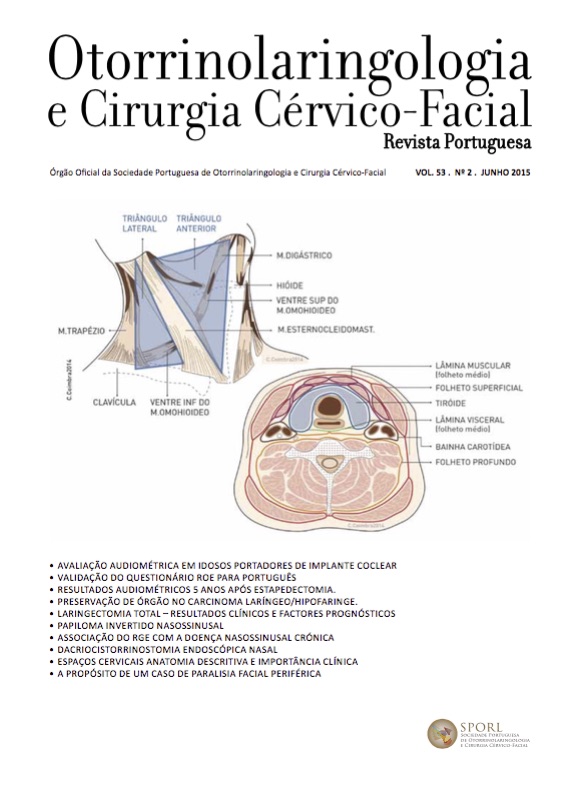Locally Advanced Laryngeal/ Hypopharynx Carcinoma: Organ Preservation Protocol!
DOI:
https://doi.org/10.34631/sporl.582Keywords:
larynx, organ preservation, chemotherapy, radiotherapyAbstract
Objective: Understand the role of organ preservation protocol in locally advanced laryngeal/ hypopharynx carcinoma, as well as, to be able to found out predictive factors.
Study design: Retrospective
Material and Methods: The study selected all the patients treated between 2004 and 2009. All patients began treatment with induction chemotherapy followed by radiotherapy and concomitant or subsequent chemotherapy. The results were analyzed by clinical and image evaluation.
Results: The study included 43 patients with a mean age of 55 years, 97.7% were male. 65.6% respond to the induction chemotherapy, being influenced by the type of chemotherapy used. Local or regional recurrence occurred in 23.3%. Overall survival was 65% at 1 year, 44% at 3 years and 35% at 5 years. Age (p = 0.026) and tumor size (T) (p = 0.020) appear to influence overall survival.
Conclusion: The study showed that chemotherapy followed by concurrent radiochemotherapy is a valid alternative to surgery in locally advanced tumors of the larynx.
Downloads
References
Wang C J, Knecht R. Current concepts of organ preservation in head and neck cancer. Eur Arch Otorhinolaryngol. 2011; 268:481–7.
Weisman R A, Moe K S, Orloff L A. Neoplasms of the Larynx and Laryngopharynx. In: Wackym S and Snow J B (Eds) Ballenger’s Otorhinolaryngology Head and Neck Surgery,Mcgraw-Hill Professional;2009:1255-97.
Lefebvre J L, Chevalier D. Cancers du Larynx. Encyclopédie Médico-Chirurgicale (Elsevier SAS, Paris), Oto-rhino-laryngologie, 20-710-A-10, 2005.
León X, López-Pousa A, Vega M, Orús C, et al. Results of an organ preservation protocol with induction chemotherapy and radiotherapy in patients with locally advanced laryngeal carcinoma. Eur Arch Otorhinolaryngol. 2005 ;262: 93–8.
Forastiere A A, Goepfert H, Maor M, et al. Concurrent Chemotherapy and Radiotherapy for Organ preservation in Advanced Laryngeal Cancer. N Engl J Med. 2003; 349: 2091-8.
Bosetti C, Garavello W, Levi F, et al. Trends in laryngeal cancer mortality in Europe. Int J cancer. 2006; 119: 673-81.
Bernardo M, Nunes O. Tumores da cabeça e pescoço: o que há de novo na quimioterapia. Cadernos Otorrinolaringologia. Clínica, investigação e inovação. 2010; (Dezembro): 1-12.
Wolf GT, Hong WK, Fisher SG, et al. Induction chemotherapy plus radiation compared with surgery plus radiation in patients with advanced laryngeal cancer. The Department of Veterans Affairs Laryngeal Cancer Study Group. N Engl J Med. 1991; 324(24):1685-90.
Lefebvre J L, Chevalier D, Luboinsky B, et al. Larynx preservation in pyriform sinus cancer: preliminary results of a European Organization for Research and Treatment of Cancer phase III trial. J Natl Cancer Inst. 1996; 88: 890-9.
Forastiere AA, Maor M,Weber RS, et al. Long-term results og RTOG 91-11: a phase III trial to preserve the larynx – induction cisplatin- 5FU and radiation therapy versus concurrent cisplatin and and radiation therapy versus radiation therapy (abstract from ASCO Annual Meeting proceedings Part I). J Clin Oncol. 2006; 24(18):5517.
León X, López M, García J, et al. Resultados de un protocol de preservación de órgano en pacientes com tumores localmente avanzados de la laringe. Acta Otorrinolaringol Esp. 2009, 60 (3): 176-85.
Franchin G, Vaccher E, Politi D, et al. Organ preservation in locally advanced head and neck cancer of the larynx using induction chemotherapy followed by improved radiation schemes. Eur Arch Otorhinolaryngol. 2009; 266:719–726.
Calais G. TPF: A Rational Choice for Larynx Preservation? The Oncologist. 2010;15 (3): 19-24.






